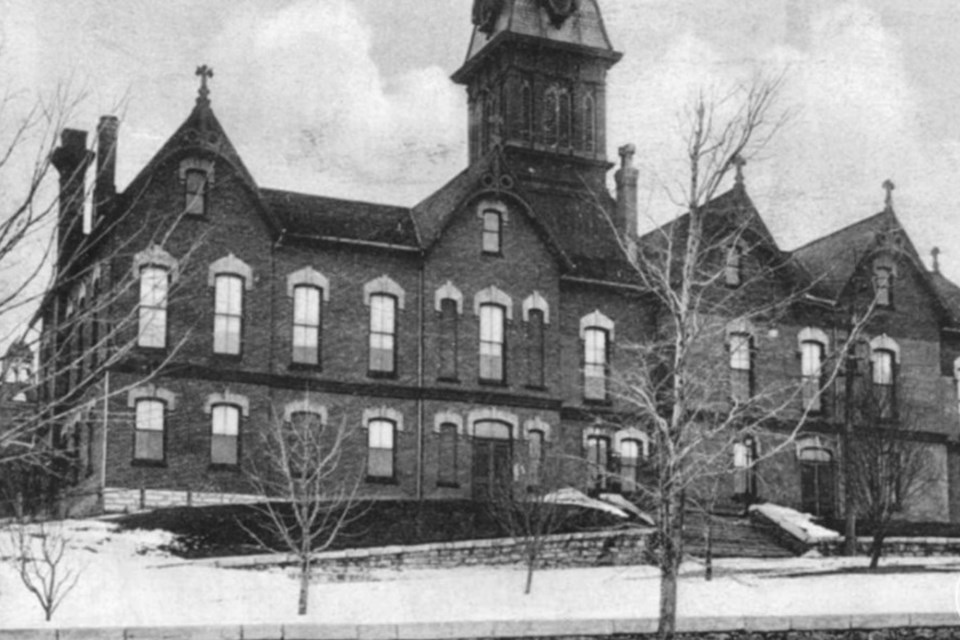Although gone from the Barrie landscape for a mere 50 years, this beautiful estate on St. Vincent Street called Abbeyleix has disappeared into the mists of time like some kind of lost civilization.
No photographs seem to exist. Images of the buildings and elaborately manicured grounds reside only in the memories of people who grew up in the east end of Barrie.
Abbeyleix, more commonly known as the Brock Estate, was located at 33 St. Vincent St. Three genteel unmarried sisters, Gertrude, Muriel and Lillian Brock, purchased the estate in 1921 as a summer getaway from their Toronto life.
Earlier recollections of the Brock estate involve orchards and prize-winning flower gardens, a fish pond and waterfall, a winding stonewalled driveway, and a sprawling main house with the grandest of staircases. After the last sister died, the house began to show its age and the local children were certain it was haunted.
It has been suggested that the main house was constructed as early as the 1830s, perhaps for John Jervis the Earl of St. Vincent himself. This seems unlikely as the property was still held by the Crown until 1846, and the earl had died in 1823.
The first registered owner was Thomas Daniel Lloyd. Lloyd was from a once well-connected family from County Wexford, Ireland. He was born during a time of great upheaval as Wexford was then experiencing some of worst atrocities of the 1798 Irish Rebellion.
The Lloyds found peace and success in Canada. Thomas Lloyd had trained in fine arts in Ireland but traded his paint brushes for an axe as the family carved out a homestead for themselves in the woods of Hastings County.
Thomas Lloyd was living in Toronto in 1843 just as the District of Simcoe was being formed. Judge Gowan appointed Lloyd to the position of deputy clerk for the Crown. After Division Courts were created, Lloyd became the clerk for Barrie.
The fine old house was likely built in 1846 as this was the year that the land was purchased, as well as the year Lloyd married Matilda McVity.
It was during the Lloyd years that the estate gardens began to take shape. By the 1870s, the orchard was well established and Thomas Lloyd’s apples regularly won prizes at the Barrie Fair. Lloyd was one of the first to attempt the cultivation of grapes in this northerly climate.
Thomas Lloyd retired from work in 1880 and pdied 10 years later. His son, Allen J. Lloyd, had succeeded him in the clerkship of the Division Court and his younger son, Robert W. Lloyd, took charge of Thomas’s house and property.
Francis Watt, a retired Toronto merchant, was associated with the estate for a brief period. He arrived in Barrie in 1901 and died six years later.
Joseph Edward Montagu Leeds bought the house in 1912. Montagu Leeds was born in England and was the grandson of the second Baronet of Croxton Park in Cambridgeshire. As a young man, he had followed his dream of becoming a rancher in the wilds of the Canadian west and began homesteading in southern Alberta in 1886.
In 1902, he married Kathleen McCarthy of Barrie, a daughter of Dr. John L. G. McCarthy. The couple later retired from ranch life and came to Ontario. In 1912, they purchased what was then known as the Watt property.
Kathleen Montagu Leeds died in January 1921. It would appear her husband could not bear to be in the St. Vincent Street home without her and, in April of that year, he sold the property to three wealthy sisters and quickly departed for a five-month tour of Alberta and British Columbia.
In fact, Mr. Montagu Leeds spent most of the next eight years on the move, spending months at a time in England or on the west coast. In 1929, he married again, making Agnes Lancefield his second wife.
With the coming of the Brock sisters, the estate would acquire a new name, one that meant a great deal to these ladies.



